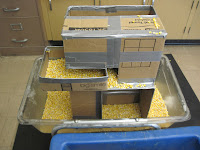The Boxes in Boxes apparatus started with 11 boxes in two tables.

There are six boxes---all connected---in the larger blue table on the left and there are five boxes---all connected---in the smaller clear table on the right.
Over the course of three weeks, the apparatus grew to over 25 boxes---all connected. This view is looking at the apparatus from the perspective of the smaller table.
This is the view looking at the apparatus from the bigger blue table.
I wrote about the first addition to the apparatus in the last post because of the need to fix a design flaw.
Both boxes were inserted through the sides of the larger box and anchored by the lip of the blue table. Inserting the boxes after the fact was quite easy.
 I used the lip of the table to measure the height at which the box would be inserted; traced the shape of the box on the side of the larger box; and cut the hole.
I used the lip of the table to measure the height at which the box would be inserted; traced the shape of the box on the side of the larger box; and cut the hole.Before the box was inserted, a hole was cut in the bottom of the box in one corner.
To understand the full connectedness here, you need to understand that there is a hole where three boxes meet that is not visible from the outside. That way, corn from other boxes ends up in the newly embedded box and then drops into the bottom of the table.
I embedded another box with the same operation on the set of boxes in the smaller table
I then added another box that connected the two sets of boxes in each of the tables. That addition formed a bridge that allowed the children to move the corn from one table to the other.
Of course, there are holes connecting the boxes in the smaller table with the bridge box and another hole at the end of the bridge box over the blue table so corn can be moved back and forth between the two tables through the box structure.
We are not done yet. I added another box on the outside of the small table that rested on the floor and was connected to the existing structure in the smaller table.
Though the box goes all the way to the floor it has a false bottom. How do you make a false bottom? You run a sheet of cardboard through the box and support it with another box inside the original box.
That all gets taped up and then a hole is cut in the top of the box.
Without the false bottom, the corn would be way too deep for the children to reach. As is, it is just the right height to dangle an arm in and finger the corn while you watch your friend play with the cars.
Did you follow all that? If you did your spacial literacy is off the charts. The children in the classroom have an distinct advantage because they get to explore the spaces with their whole being. Watch!
As you saw in the video, the children were all over the apparatus. They were over, under, around, and through it. The result of all that exploration: a sense of space borne through their own actions and operations.
To conclude and to make the point for spacial literacy, here are six more pictures of children exploring the apparatus. Enjoy!

















No comments:
Post a Comment